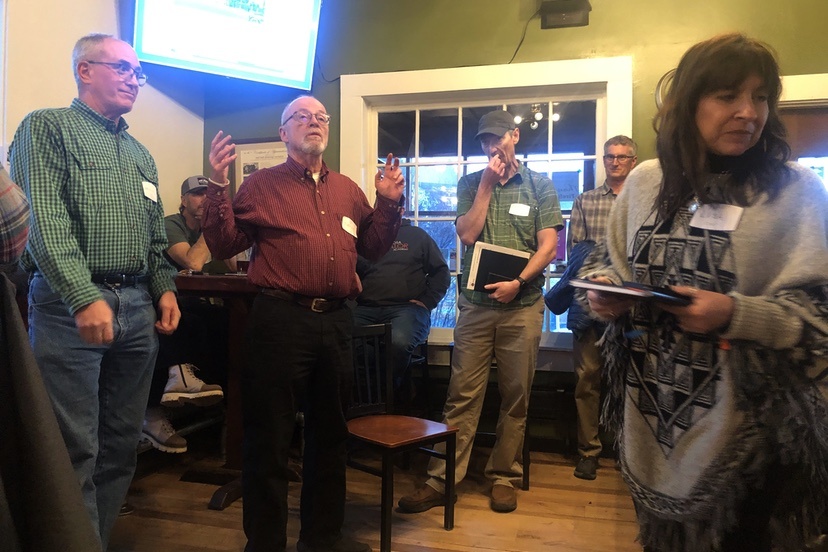We’re listening here to Kevin Curry, program engineer for Colorado Department of Transportation (CDOT) Region 5, speaking to a roomful of mostly downtown business owners and managers at Riff Raff Brewing on February 13. We had come to learn more about the two-year (or three-year?) highway reconstruction project that will soon be plaguing downtown businesses, residents and visitors… as the problematic asphalt surface of Highway 160, between S. 8th Street and N. 1st Street, gets replaced with a concrete surface.
Sidewalks will also get replaced, along with some streetlights and underground utilities.
Mr. Curry:
“There’s a bunch of utility work that needs to get done. Geothermal lines, storm sewer. We’re putting in fiber optic conduit through town. If you recall, our recent Wolf Creek job, and actually this job, we brought in fiber optic lines. That’s going to continue through town. Then, pedestrian crossing signals; I believe there’s three of them going in? And then, some other work.
“It will be… it will be intense. I’m sorry. It’s a crowded area. We expect it to be two years, with a winter shutdown. That remains to be seen, when we get a contractor. They will tell us what they are going to do, because CDOT relies on them to give us their schedule of how they plan to do it.”
In other words, CDOT has not yet selected a contractor.
“We have contacted concrete contractors across the state, who have done work for us in the past, and we told them that this is coming. They’re very interested, so I think we’ll get some good reaction on bids.
“The project hasn’t been advertised yet.” He addressed the other CDOT staff standing beside him in the room. “We’re about two or three weeks out? Does that sound about right?”
CDOT has already solicited bids, however, for a consultant to act as construction manager, and that will include a public information specialist. So maybe Pagosa will get regular PR updates, to help us understand the depth of our suffering.
“Typically, we require the contractor to hire the public information person… But we decided we wanted to have more control of it, for this specific job. We haven’t done this very often, at least not down in this region.” CDOT expects to hire the construction manager within the next month, in time for the construction contract to be awarded.
“We are going to maintain two lanes of traffic throughout the project, so we’ll have one-way traffic in each direction. However, there’s one place near [the 1st Street Bridge] where it’s narrow, so we’re not going to be able to have two lanes through there. So we’ll have one lane, alternating with a signal.”
Some of the concrete, he said, would be “high early concrete” which sets up faster than normal concrete, and can accommodate traffic loads within a couple of days — instead of a week or more, for normal concrete.
Mr. Curry then invited CDOT engineer Arthur Miller, to share some additional information about the project.
Mr. Miller:
“When you come in with a project like this, you have storm sewer, waterlines, sewer lines; you have all this infrastructure running underneath the roadway, as well as what everybody sees on the surface.
“When you’re doing a concrete roadway, it becomes more critical to make sure we have what’s underneath the roadway taken care of, because the last thing you want is to start ripping out panels, afterwards, because you have a waterline leak.
“So we’ve been working with the Town, with PAWSD, with all the different districts, so we can coordinate getting that infrastructure taken care of, as we work through the project, as we’re tearing it up.
“When you think about it, and you’re talking about ‘phasing’ — oh, my, that creates a nightmare. Because now you’ve got to coordinate not only what’s above the ground, but we also have to coordinate what’s underneath the ground…
“We use our engineer brains, to try and come up with a plan. But we don’t say, ‘This is the plan.’ We know that the contractors come up with some pretty darn good ideas, too. So once we get the contractor on board, there will be more discussions with them — their means and methods. They might say, ‘If we can do it this way, we can knock this out in this amount of time.’
“So this is just kind of a general plan, that we have right now. Obviously, we know what summertime is like, here in Pagosa. So we’re going to try and always keep two lanes of traffic going. Which means, we have to ‘phase’ by half of the roadway.
“We’ll tear out half the roadway, work on it. At the intersections, we’re going to alternate, so circulation through town can still happen and we don’t cut you guys off from getting access to the roadway…
“The communication part is going to be very critical during construction, so we know what issues you are seeing. Obviously, we’re geeky engineer types. We won’t see some of the things you will be seeing…
“All the intersections will be ‘high early’ concrete. We’ll be doing a lot of that work at night…
“So we’re looking at a two-season project. When you first see it starting, and you think it’s moving really slow, that’s because there’s a lot of work happening underneath the ground… Once you get the underground stuff, that paving machine comes in and it goes fast! And everybody is going, ‘YES!’
“And then people ask, ‘Why didn’t they do that earlier?’ Right?”
He laughed.
“It’s all that prep work that takes forever to get done…”
Of course, Mr. Miller didn’t mean ‘forever’ in the literal sense.
A couple more key pieces to the story:
Pedestrian traffic.
And parking.

